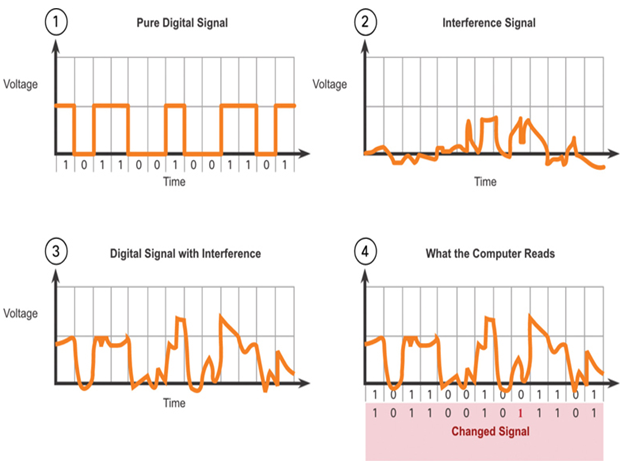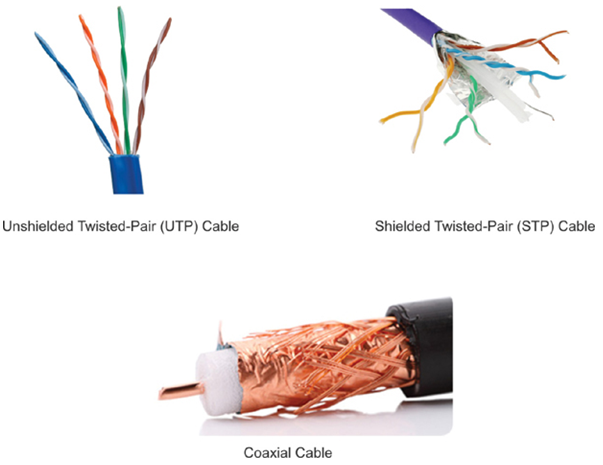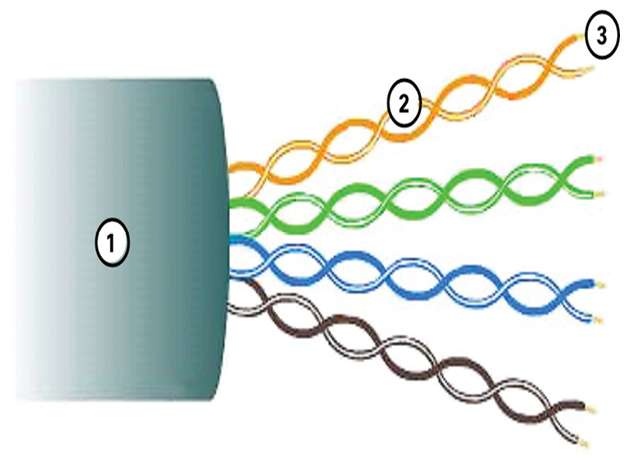One of the oldest and most used media for communications is copper cabling. The characteristics and use of copper media in data networks will be examined in this topic.
Characteristics of Copper Cabling (30.3.1)
Copper cabling is the most common type of cabling used in networks today. In fact, copper cabling is not just one type of cable. There are three different types of copper cabling that are each used in specific situations.
Networks use copper media because it is inexpensive, easy to install, and has low resistance to electrical current. However, copper media is limited by distance and signal interference.
Data is transmitted on copper cables as electrical pulses. A detector in the network interface of a destination device must receive a signal that can be successfully decoded to match the signal sent. However, the farther the signal travels, the more it deteriorates. This is referred to as signal attenuation. For this reason, all copper media must follow strict distance limitations as specified by the guiding standards.
The timing and voltage values of the electrical pulses are also susceptible to interference from two sources:
• Electromagnetic interference (EMI) or radio frequency interference (RFI) — EMI and RFI signals can distort and corrupt the data signals being carried by copper media. Potential sources of EMI and RFI include radio waves and electromagnetic devices, such as fluorescent lights or electric motors.
• Crosstalk — Crosstalk is a disturbance caused by the electric or magnetic fields of a signal on one wire to the signal in an adjacent wire. In telephone circuits, crosstalk can result in hearing part of another voice conversation from an adjacent circuit. Specifically, when an electrical current flows through a wire, it creates a small, circular magnetic field around the wire, which can be picked up by an adjacent wire.
Figure 30-10 shows how data transmission can be affected by interference.

Figure 30-10 Affect of Interference on Data Transmission
1. A pure digital signal is transmitted
2. On the medium, there is an interference signal
3. The digital signal is corrupted by the interference signal.
4. The receiving computer reads a changed signal. Notice that a 0 bit is now interpreted as a 1 bit.
To counter the negative effects of EMI and RFI, some types of copper cables are wrapped in metallic shielding and require proper grounding connections.
To counter the negative effects of crosstalk, some types of copper cables have opposing circuit wire pairs twisted together, which effectively cancels the crosstalk.
The susceptibility of copper cables to electronic noise can also be limited using these recommendations:
• Selecting the cable type or category most suited to a given networking environment
• Designing a cable infrastructure to avoid known and potential sources of interference in the building structure
• Using cabling techniques that include the proper handling and termination of the cables
Types of Copper Cabling (30.3.2)
There are three main types of copper media used in networking, as shown in Figure 30-11.

Figure 30-11 Types of Copper Cabling
Unshielded Twisted-pair (UTP) (30.3.3)
Unshielded twisted-pair (UTP) cabling is the most common networking media. UTP cabling, terminated with RJ-45 connectors, is used for interconnecting network hosts with intermediary networking devices, such as switches and routers.
In LANs, UTP cable consists of four pairs of color-coded wires that have been twisted together and then encased in a flexible plastic sheath that protects from minor physical damage, as shown in Figure 30-12. The twisting of wires helps protect against signal interference from other wires.
The color codes identify the individual pairs and wires and aid in cable termination.

Figure 30-12 UTP Cable
The numbers in Figure 30-12 identify some key features of UTP cable:
1. The outer jacket protects the copper wires from physical damage.
2. Twisted-pairs protect the signal from interference.
3. Color-coded plastic insulation electrically isolates wires from each other and identifies each pair.
